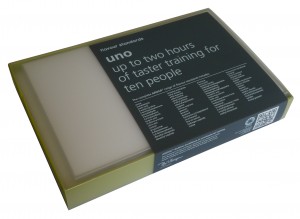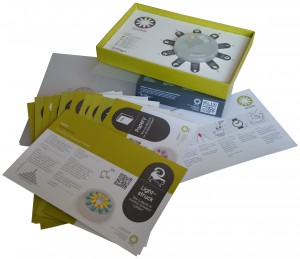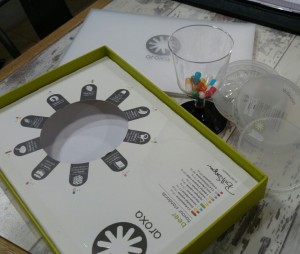I bought this Aroxa “beer uno kit” last year. They’re designed to make a litre of tainted beer per capsule so it seemed rather wasteful doing it with just Kat and I so we sat on the kit for a little while until we could organise an appropriate get-together (Note: BBE date on kit was July 2014 and kit was kept in a cool & dry spot). Eventually we managed to get a couple of other people involved and we did the tasting on Wednesday March 13, kindly hosted by The Table in Cambridge. It’s a pity we didn’t have a few more folk, but alas I don’t actually have that many beer-chums in Cambridge. (I should have popped down to North Herts for this I suppose.)
In the end our tasting panel consisted of Bob Arnott, Andrea from The Table, Kat and myself – plus a random chap who popped in for a coffee and tasted a couple of samples. I rocked up with 2 boxes of Budweiser (much to the amusement of one of the regulars), my own jug, and some plastic sample “glasses”. The Table folk provided water and some palate-cleansing plain bread.
The Table is on busy Regent Street – it has a huge plate-glass window and we were using the eponymous large central table. I definitely got some funny looks from passers by… twisting open colourful medicine-like gelcaps and pouring their content into a jug, whilst surrounded by cans of Bud…
Unboxing
The Aroxa kit is beautifully packaged. I appreciate the quality and look of it but do wonder how much it adds to the price. What you get for your money includes great presentation and plenty of information.
Want even more information? There’s a QR code on each card leading to the Aroxa page for the flavour. I’d thought at first this could be a useful tool for presenting the information on a large screen… but the format isn’t really right for that, it is also a bit of a drawback that the pages on the Aroxa site really don’t work well on small screens.
There is an instruction card which is clear enough. The only note I’d make is that some of the capsules were quite difficult to open… not so simple as “twist off top”. Half of them needed a firmer grip and a bit of a squeeze to loosen. I gave in and had to rip the top off one capsule.
I poured everyone a “control” glass of Bud, and then we worked through the flavours in the order listed in the box…
2,3-butanedione – Diacetyl – “like butter, or butter popcorn”
A classic? Also much debated – most brewers I know seem to hate even trace diacetyl, due to it being an indicator for a pile of sloppy practices. However as the notes for this one say, it is sometimes considered appropriate in some styles of beer. I have also heard it asserted by some brewers that this is total garbage.
All a matter of taste? Sometimes when you’re tasting beer and this one comes up you’ll overhear someone say what a wonderful butterscotch note it has – or what a great buttery mouthfeel. They love it – and this is not uncommon.
Diacetyl has interested me for a long while as it is much discussed and I’ve never been sure if I’m detecting it properly. All of us had some trouble picking this one up on the nose although I think it was pretty distinct on an initial short-sharp snort for me. In the mouth the difference was clear – albeit the taint quite light (according to all of us). The Bud had an added mouthfeel and even umami from the diacetyl. I think we all thought it was actually better than plain Bud!
dimethyl sulphide – DMS – “like sweetcorn or tomato sauce”
Another one commonly talked about – usually in the context of lagers. Not one I’ve given much thought to and I don’t think I’ve ever detected it distinctly in any beer – I don’t drink much lager in general.
Like the diacetyl we all had trouble picking this up distinctly on the nose – but there seemed to be something there. To me the first sip of the tainted beer was “horrid” – from my notes. And correct to its reputation – creamed sweetcorn I thought. The horridness quickly dissipated however, and a couple of sips later it was in “I could drink it” territory.
I really don’t know about the “tomato sauce” element to this. But I’m not really a user of tomato sauce.
ferrous sulphate – Metallic – “like ink or blood”
This one I know mostly from times when I open a bottle and sadly note a bit of rust around the top. Bad quality caps? I clean the rust off and hope the taint isn’t in the beer – invariably it is.
The taint gave the Bud a sharp astringent aroma, although only lightly so. On taste it was immediately obvious – and pretty undrinkable to all of us… except for a random chap who’d wandered in for coffee. I gave him a sample of this and of plain Bud and he preferred the ferrous sulphate tained one. So there you go… no accounting for taste.
I don’t drink ink, and only have a passing familiarity with blood – but yes, there’s a definite resemblance to the latter. More so iron nails – ever do some woodwork and for lack of a better option hold some nails in your lips? That. It might also be akin to heavily tannic wines.
hop oil extract – Hop oil – “like hoppy ale”
We weren’t sure what to expect from “hop oil” – given this is a bit of powder in a capsule we weren’t really expecting “hoppy” in the modern sense. And it wasn’t – it was a bit odd really.
This one divided us a bit. I got a peppery thing on the nose, not unlike some hop notes – but it really didn’t agree with my mouth. There was a pepper/resin hint but mostly a horrid sort of crushed-ant formaldehyde/plasticy thing at the back of my mouth and up the nasal passages. I found it quite unpleasant. On my side was the random ferrous sulphate lover… odd.
Kat and Bob didn’t mind this one so much, definitely seeming to have enjoyed it at first. Kat says that for her it built up from being OK to being unpleasant.
I’m not sure what the use of this flavour standard is… it didn’t give me an experience akin to anything I’ve had with a beer before. The card says “like hoppy ale”… hmmm.
hydrogen sulphide – H2S – “like boiled or rotten eggs”
The classic “Burton snatch” – the struck match of a Burton ale. I found this pretty much clear and as expected on the nose, albeit a bit on the stronger side than usual. Funnily enough it seemed to improve the beer in the mouth – adding an umami not otherwise present, that fended off the bland sweetness of Bud.
A pretty simple one really – although Bob found it at odds with his typical experience of classic Burton ales such as White Shield (which he drinks a lot of because as well as being a good beer the bottles are great for homebrew – labels come off with ease… noted!) I’ll grab some White Shield next time I see it… for “research” purposes. Bob also suggested trying Adnams Southwold Bitter for similar “research” reasons. (Both are beers I’ve had in the past – but not recently, and very infrequently.)
Personally this one hit home, reminiscent of beers for which I’ve often remarked “this seems heavily Burtonised”. Although I probably have my finger on the wrong button there as the sulphury note is probably caused by other problems.
isoamyl acetate – “like bananas or pear drops”
Yep, banana. Pretty distinctive… and really very odd to drink Bud with this taint alongside normal Bud. It really could have been a crappy Kristallweizen!
Not much else to add… flavour wise just a bit too lolly-banana compared to the real thing, but this is probably because it lacked other flavour elements of a proper wheat beer. Pear drops? I’ve never had one. I must find some to enhance my flavour education because this is used a lot in flavour descriptors. Albeit Bob and Andrea didn’t seem to get much of a pear drop note out of this one – it was all banana.
3-methyl-2-butene-1-thiol – Light-struck – “like a skunk or freshly-brewed coffee”
This was an interesting one for all of us. A much discussed beer problem and one we all think we know – but without certainty. How many Brits have sniffed a skunk?
Immediately and distinctly obvious on even “arms length” aroma. I got strong whiffs of it as I prepared the tainted beer. And it really is that “supermarket lager” smell… you know, typical multinational brand clear and green glass sort of stuff. Now I’ve had it confirmed I know I’ve smelt this many many times before.
The taint even came through pretty strongly in the mouth for all of us – which I think isn’t usual when present in beer. None of us really “got used to it” either.
Skunks I don’t know… and whoever thinks freshly brewed coffee smells like this really needs to buy better coffee. Yuck! All of us were drinkers of good coffee in various formats, and we were sitting in a good coffee shop – the opinion on this was unanimous. However – the strong aroma gave me an immediate shot of nostalgic recollection. It’s a smell I’ve come across bushwalking back home in Western Australia. But from what? I think it is particular to scrubby coastal area. Most likely a particular plant. Sort of a heavy musky animal aroma.
trans-2-nonenal – Papery – “like cardboard or oxidized beer”
Ahhh… all cask ale drinkers know this one far too well. Sadly. It is a serious problem in UK “real ale” drinking, oxidation is rife in cask ale.
Yet I drink with folk who’ll happily down several pints of a really quite nastily oxidised beer and claim it is wonderful. Then there are the ones who’ll drink a good hop-forward golden ale and claim it “nasty” but love it when it is still on three days later because it has “smoothed out” and “mellowed”. Ah, anyway, enough of a rant.
On the nose this was pretty typical and what I expected. In the mouth *POW* … yuck. Worse than I’ve ever found in a beer, thankfully. It was pure “wet cardboard” – the flavour sense directly akin to a strong wet cardboard aroma.
2,4,6-trichloroanisole – Musty – “like corked wine or a damp cellar”
A slight odd-one-out being a taint none of us had really heard much about before. “Musty” beer?
The aroma was distinct and horrible. Mildew. Damp. I took a sip. I spat it out. Disgusting. It was like drinking the smell of damp. Retch. Quoting Bob: “Fuck, that is revolting!”
In the distant past I’ve done a wine tasting and sales course and had to taste corked wine. And yes, quite similar – horrible mouldy flavour. Sometimes well hidden in big strong reds, but distinct if you know what you’re looking for. Thankfully I have never had this in a beer, and I hope that remains the case. However I do think I’ve had very similar in several ciders. Cider is a minefield of horrible flavours.
4-vinyl guaiacol – Phenolic – “like cloves or wheat beer”
On name alone this didn’t come out as we expected. In the beer world “phenolic” tends to be use a lot to describe smoky flavours, we were thinking Islay whisky – “yay” thought me, and “yuck” thought Bob. It’s Islay versus Speyside – I’m firmly in the Islay camp.
However – this is a different phenol, much to Bob’s relief. The aroma was a bit Belgian, and the flavour more so. Whilst the notes say a signature of German-style Wheat beers Bob though more Wit than Wheat. I thought Hoegaarden – so that’s about right.
This is another one that made the beer more palatable to me, even if in a very odd “flavoured beer” sort of way. As for “cloves” – I’m not so sure, maybe lightly so but with a slight coriander seed element, or that could just be some associative memory. I’m the sort of weirdo who will occasionally fish a clove out of the spice cupboard to chew on, so as a flavour I know it very well.
Wrap Up
All up this was an excellent fun exercise. I think if you have 8 or so folk in a homebrew club, or similar, it would be well worth splitting up the cost of a kit a like this and giving it a go. For some this will just be for confirmation and thus confidence… yes, that really is “skunk”, etc. For others it might be a bit more eye-opening. The advantage of having at least 8 people is that it won’t cost you much more than a tenner each. Not bad for the experience.
However – a single pass like this is fun and interesting, but I don’t feel it is enough. If I had such a club of people I’d try to arrange four dates and get four kits. Do the first run and then do a series of blind tastings. Really lock in some certainty. It’d still cost you less than 50 quid per person – if you’re a flavour and beer nerd like me that’s money well spent I reckon. I’m not personally sure the 10 flavours in the Aroxa kit are ideal though – and I’d carefully consider the competition, FlavorActiV is a bit more expensive but has a different set of flavours and also a 20-flavour kit. And I could really have done without that “mouldy” 2,4,6-trichloroanisole … despite hardly putting any in my mouth I thought I could still taste it an hour later. [Edit: Rich of The Beer Cast has now written up his experience with FlavorActiV kit – check it out for a comparison!]
A brief discussion was had about whether or not you could do this sort of thing as a paid-for gig. A format involving sampling tainted beer followed by some good beers and food would be the way to go we thought. But what would people pay? Probably not enough… the 10-flavour Aroxa kit is £82.80 (FlavorActiV do a similar one for £96 inc-VAT), the required 11 litres of Budweiser (or similar) is about £25, add in some food and decent beer at a price of, say, £15 per head … assuming 8 to 10 people you have a per-head cost range of £25-£30 quid. Would someone pay £50 for a session like this? (First test: would I? I’m not sure. I’d probably consider it… but then I’m a beer nerd, I’m shelling out much more to do a 2-day Beer Academy course.) Maybe with the good food and beer split out of the price as an optional “good food and beer will be available to purchase after” – and thus a price for just the tasting of about £35?
Thanks once again to The Table for providing space (and bread) for the tasting session. Do visit them – they have great food, excellent coffee, and also some tasty beers in the fridge. We were mighty glad to cleanse our tastebuds with some Pressure Drop and Five Points brews after the session.





